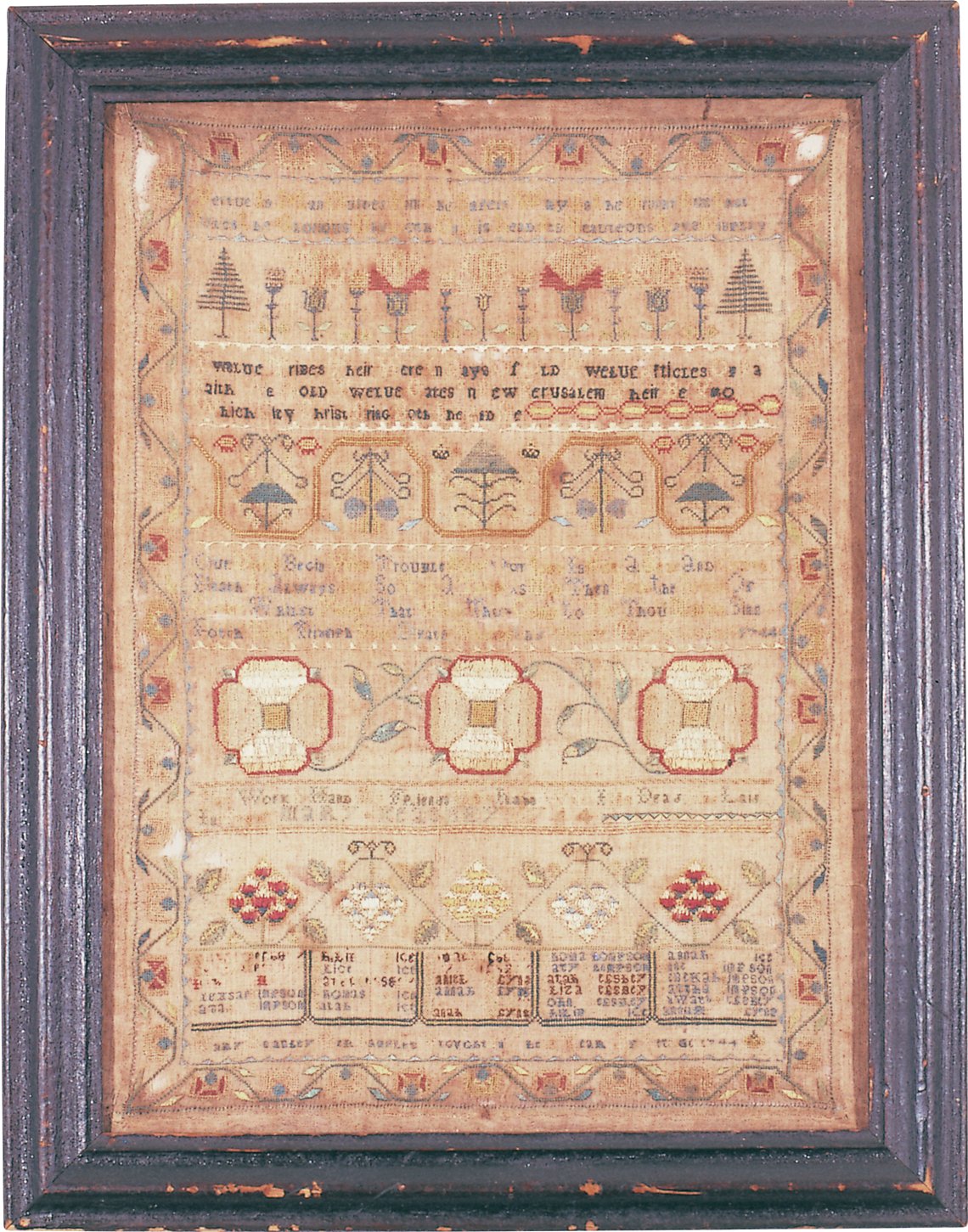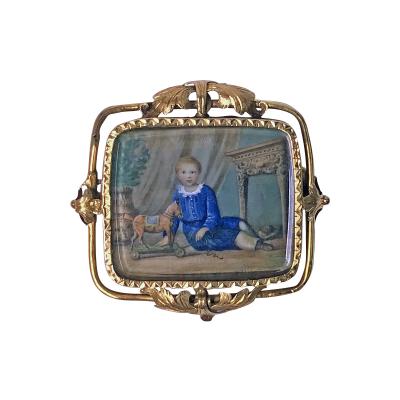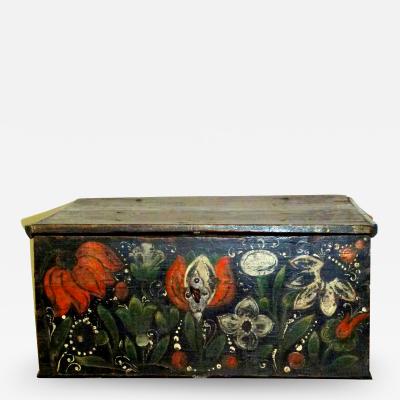Know Your Antiques: Sampler Comparisons
 |
by Stephen and Carol Huber
 |
amplers, silk embroideries, and canvaswork pictures are extraordinary examples of needlework skill wrought by girls and young ladies from the late-seventeenth into the mid-nineteenth centuries. When exhibiting at antiques shows, we observe visitors to our booth studying needleworks and reading their tags. Some are obviously familiar with the subjects and others appear perplexed. Those in the latter group often ask, "What makes one sampler more valuable than another?" To the novice, it’s difficult to identify the seemingly slight differences that make one piece priced in the tens of thousands of dollars and another worth a fraction of the amount.
As in any field, prices vary widely and are dictated primarily by sales of similar pieces, condition, and appeal. When judging needlework, visual impact and graphic design are extremely important, followed closely by condition. We urge clients to purchase fewer pieces in better condition, aiming for quality, not quantity.
Offered here are two brief comparisons that we hope will serve as a beginning guide to the types of things one should consider when collecting antique needlework. All four examples presented here are very fine samplers, but there are aspects that differentiate them in regards to valuation.
 |
 |
 | |
| Mary Keasbey Her Sampler Wrought in the 13th Year of Her Age 1744. Silk on linen; 15-3/8 x 11-1/2 inches. Mary was the daughter of Mathew Keasbey and Sarah Simpson, born on February 24, 1732/33, in Salem County, New Jersey. |
Overall Assessment
The early date is a strong point in terms of its rarity and, hence, value. The frame appears to be original, which is highly desirable and unusual for such an early sampler.
Condition
This sampler has some overall condition problems that affect the price. There are small holes in the background fabric, some staining, and some thread loss.
Known School / Provenance
The provenance is exceptional. The sampler is from the ex-collection of noted needlework collector Joan Stephens, which sold at Sotheby's on January 19, 1997. Based on the design of her sampler, Mary Keasbey presumably attended school in Philadelphia. As needlework historian Betty Ring has noted, "Mary Keasbey's sampler reflects the continuing popularity of a familiar Philadelphia form that emerged in the 1720s and is most notable for columns of family names below band patterns interspersed with tightly worked pious inscriptions. Mary's work has some of the earlier patterns but she may have introduced the two prominent lower patterns. They continued throughout the century and were evidently favored by Mary Askew, teaching in Delaware in the 1780s."1
Valuation
$10,000 to $20,000
 | |
| Phebe Yarnall Her Work in the 14 Year Of Her Age 1789. Silk on linen; 16-1/4 x 12 inches. Phebe was the daughter of John Yarnall and Elizabeth Newlin, born on April 20, 1776, in Wilmington, Delaware. |
Overall Assessment
Phebe's sampler is stunningly crisp. The use of several different types of embroidery stitches (Queen, cross, long, and chain) indicates Phebe was a talented needleworker.
Condition
In excellent condition with only slight thread loss. The silk remains lustrous.
Known School / Provenance
Phebe made this sampler under the tutelage of Mary Askew, a former student of noted Philadelphia needlework teacher Ann Marsh. Only a few other samplers are known to exist from this school and thus rarity is a factor in its valuation.2
Valuation
$50,000 to $60,000
Comparison
The large four-petal flower band in both of these samplers, which are dated forty-five years apart, illustrates the continuation of decorative traditions. Based primarily on the difference in condition, the more valuable of the two samplers is Phebe's.
 |
 |
 | |
| Abigail Higbee, daughter of Obediah and Sarah Higbee wrought this/sampler in the year 1838. Aged 11 years Mary McCosh. Silk on linen on linen; 22 x 28 inches. |
Overall Assessment
The folky design of this sampler makes this piece highly desirable. The birds, peacock, and cat are a unique combination. The mismatched colors of the house may suggest that Abigail started at the bottom right corner and ran out of red thread, or simply that it was the color in her needle when she started the house. It is clear that her teacher was not too particular with the resulting colors as she allowed them to be left in place.
Condition
Slight fading detracts only a little from the value of this sampler.
Known School / Provenance
Abigail's sampler is the earliest known example in a group from Western Pennsylvania that date between 1838 and 1847. Characteristic of these samplers are bold designs executed in a large format. Mary McCosh is listed on the sampler as the teacher. Though at one time it was thought that in marrying she became Mary Tidball, whose name appears as the teacher on other samplers from the group, research has proven that they were two separate instructors.
Valuation
$30,000 to $40,000
 | |
| Charlotte A. Edmonds/ 1830/ Wrought in D. H. Mundall's/Seminary/ South Fifth Street/ NO. 101/Philadelphia. Silk on linen; 26-1/2 x 22-1/2 inches. |
Overall Assessment
Beautifully worked and rich in a balanced composition. The basket of flowers in the upper section compliments the blue vase at the bottom and creates excellent graphic appeal.
Condition
The color and composition is exceptional and the use of a variety of stitches proves Charlotte's expertise.
Known School / Provenance
It is most unusual to have the address of the school included in the inscription, adding to the sampler's documentary importance. The teacher, Mrs. Deborah Hicks Mundal, is also listed. A similar piece from the Mundall school is owned by Winterthur Museum, Delaware.
Valuation
$50,000 to $60,000
Comparison
Of these two Pennsylvania pieces, the Edmond's sampler is of higher value because of its excellent condition, skillful stitching, and graphic design. Although the Higbee sampler would appeal to both sampler and folk art collectors, the condition somewhat diminishes the value.
1. Betty Ring, Girlhood Embroidery (New York, 1993), vol. II, 330-37, 488.
2. Ring, 487-89.
Know Your Antiques is a regular feature that offers insight into the world of decorative and fine arts.
Stephen and Carol Huber are noted sampler and needlework dealers and the authors of Samplers: How to Compare & Value (Millers, 2002).
This article was originally published in Antiques & Fine Art magazine. Fully digitized versions are available at www.afamag.com. AFA is affiliated with Incollect.com.
 |































